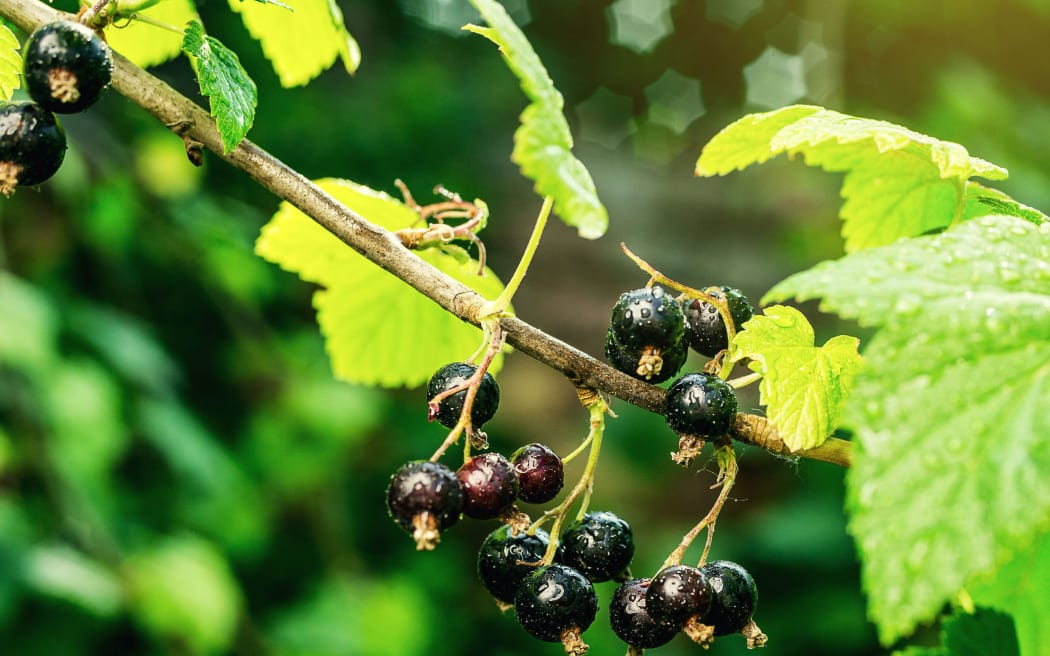Foraging is gaining popularity as fruit and vegetable prices increase, and the rise in cost of living means people are having to be more creative about where and how they get their food.
Ōtautahi Christchurch has a fruit tree map that’s available on the council’s website and more than 3000 people have visited it over the past month.
The fruit trees are in public spaces and you can freely pick things like olives, walnuts, plums and pears.

bush of black currant Photo: bondvit/123RF
Now there’s a map that’s being created for fruit trees in Christchurch’s red zone – land that was designated too unstable to build on after the earthquakes.
While houses and buildings had to be demolished in the area, trees and gardens have thrived.
Joanna Wildish founded Ōtautahi Urban Foraging group, where people exchange tips for ripe fruit crops, locations for productive trees, and recipes for foraged foods.
"What's so lovely about [the red zone] is ... it's like a wild park, like a big meadow," Wildish tells Karyn Hay.
"That's [become that way] because the community and people have said 'we don't want it to become like an English park, we want it to have those edible weeds there, we don't want sprays happening in the area because we want to be able to forage from there'.
"Lots of different groups are using it, gardens are popping up all over the place and schools are using it and community gardens are starting on the red zone as well."
The pockets of red zone areas go from Christchurch's city centre and right out to New Brighton Beach, as well as some up the hills and around Sumner too.
Along the way, you can find feijoas, walnuts, apples, mushrooms and shaggy ink cap.
"It just takes the pressure off [living costs] ... it's just something that can feel quite good and builds resilience and the support of community."
Wildish has a word of warning though - be certain about what you're taking.
"I don't go for any [mushroom] that has gills that are white underneath, because there's a bunch of them that can be poisonous.
"It is good to have someone take you and show you mushrooms in the field and then ... you get a feel for things a bit more when you actually go out and experience it."
More than just foraging, the community also takes the initiative to take care of the area and pull out any invasive weeds.
"There's only a few plants which aren't good and that's things like hemlock and old man's beard which I pull down whenever I see it on the trees 'cause it can take over areas and we've just got to be a bit vigilant with making sure it doesn't," Wildish says.
"And the same with the hemlock, which can sometimes be confused with parsley, so if I ever see that one when I'm out I just rip it out."
On the other hand, there are some weeds which are edible, like oxalis which has a lemon and pepper taste.
"I've never been that good at growing vegetables so I find edible weeds really handy, because chickweed pops up everywhere and that's so good and then there's other ones like the red dead-nettle or the nettle that you can put in a pot of tea.
"And lots of other wee ones, the puha and dandelion flowers and dandelion leaves, all of that grows very readily in wintertime.
"Miner's lettuce is another one ... it's quite a nutritious and thick leaf, it has a wee kind of white stem with a tiny little white flower at the top."
You'll most likely want to take any edible weeds from an area that you're familiar with, like your own garden, to ensure there's not been any weed spray exposure.
And plan ahead to take just the right amount you need.
"I think people get quite enthusiastic when they first start foraging and maybe they're just so excited to find stuff that they go and take stuff from the tree stuff that's not ripe.
"Just try one and if you try it and you go 'mmm, that's not so good' then leave the rest and maybe come back in a couple of weeks.
"Or maybe they pick too much and then they don't end up using what they've actually [taken]."
Wildish says if future city planning included urban farms and community gardens and orchards, then the initiative could very well expand and help feed more people.

